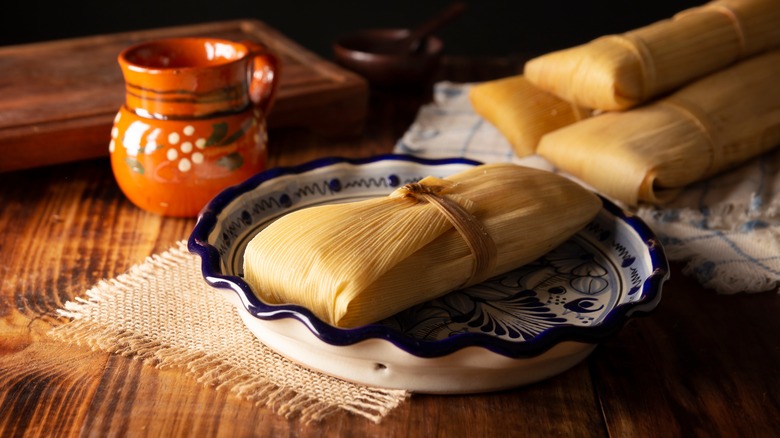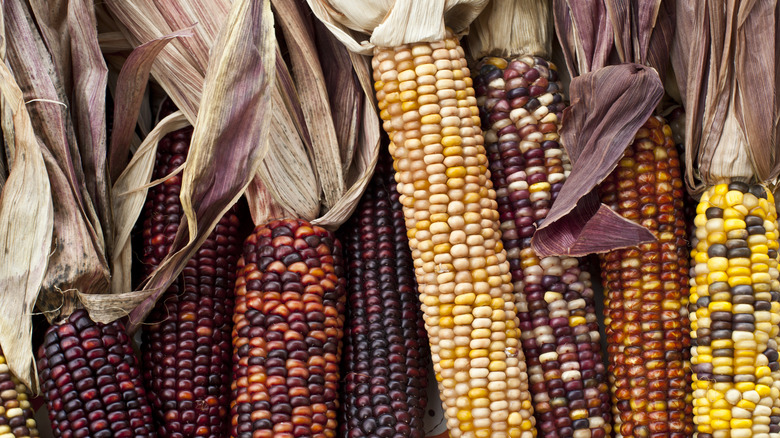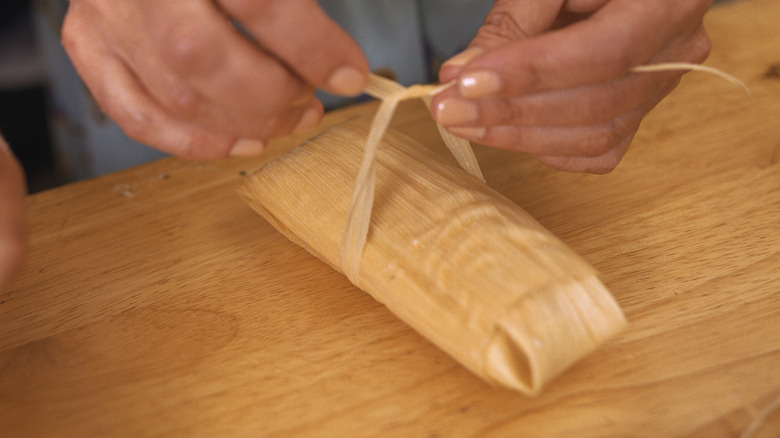Cherokee Bean Bread Is A Boiled Delicacy Filled With Significance
If you've never heard of Cherokee bean bread, you're almost certainly familiar with its close cousin, the Mexican tamale. Like tamales, bean bread features corn flour made from hominy (typically sold as masa harina). Bean bread is also wrapped — sometimes in corn husks, sometimes in soaked hickory leaves and tied with river grass – and steamed. When consuming Cherokee bean bread, on one level you'll have the gustatory pleasure of eating a humble dumpling made with corn and beans. On a deeper level, you'll be internalizing the foundations of a Native American culture stretching all the way back to Selu, the First Woman.
As a food, bean bread is a pretty simple preparation once you have the right ingredients. At its most basic, bean bread is made by adding hot beans (along with their cooking broth) to freshly ground corn hominy. The resulting moist dough is tightly wrapped and then boiled or steamed. Just as with tamales, bean bread traditionally accompanies hearty stews that resemble pozole. As you can imagine, there are many variations of this dish, which we'll get into. But first, a little history is in order.
The significance of tuya asuyi gadu
The Cherokee name for bean bread is tuya asuyi gadu. In form and function, it bears a strong resemblance not only to tamales (which are of Aztec and Mayan origin), but also to the Choctaw and Chickasaw's banaha, as well as the Diné people's Kneel Down Bread. All of these were food staples in the period prior to the introduction of wheat on the North American continent, and featured corn — a sacred grain to these civilizations.
For the Cherokee, corn is called selu, which happens to be the name of the aforementioned First Woman, sometimes known as Corn Mother. Selu sacrificed herself in order to provide corn for her descendants; wherever her blood fell, corn stalks grew. This basic tale of corn as an expression of motherly sacrifice is common among many indigenous North American cultures. Domesticated corn was essential, not only to the creation of sophisticated Native American societies, but also for the very survival of the Mayflower settlers.
How to make Cherokee bean bread
A few things are essential to making bean bread. The first, and most important, is corn flour. You can easily pick up some masa harina at the store, or you can create it the old-fashioned way through a process known as nixtamalization. Simply put, this is a way of removing the hard hull from the corn's kernel. The ancient method was to simmer shelled hard corn kernels in water mixed with hardwood ash, letting its natural alkalis soften the hulls until they could be rinsed off. (This is also a good way of adding some calcium to your diet.) The resulting hominy (or pozole, if you like) can then be ground into flour. To this, add whatever cooked beans you like — heirloom, brown, black, or pinto — as well as their cooking broth. Traditionally, salt is not added since it can make the dough crumbly.
If you want to fancy up your bean bread dough, feel free to add some combination of a beaten egg, honey, shortening, milk — and yes, even salt. Form the dough into 3-inch balls, and flatten them out (this is the reason bean bread was sometimes called "broadswords"). Then wrap the bean bread tightly in dried corn husks, which have been soaked to make it pliable. Either steam or boil them until cooked, a process which usually takes 45 minutes to an hour. Serve your bean bread to accompany an autumnal soup or our pozole verde.


